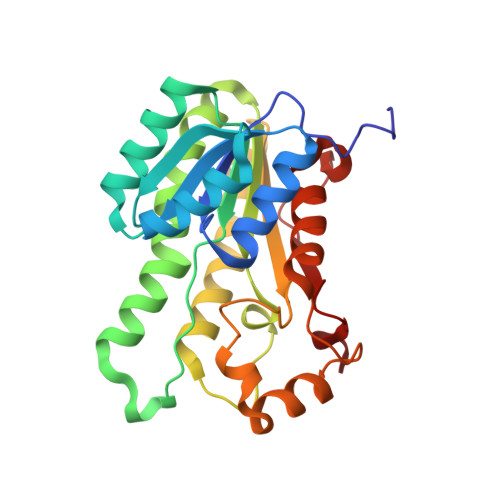Structural insight into substrate differentiation of the sugar-metabolizing enzyme galactitol dehydrogenase from Rhodobacter sphaeroides D.
Carius, Y., Christian, H., Faust, A., Zander, U., Klink, B.U., Kornberger, P., Kohring, G.W., Giffhorn, F., Scheidig, A.J.(2010) J Biological Chem 285: 20006-20014
- PubMed: 20410293
- DOI: https://doi.org/10.1074/jbc.M110.113738
- Primary Citation of Related Structures:
2WDZ, 2WSB, 3LQF - PubMed Abstract:
Galactitol 2-dehydrogenase (GatDH) belongs to the protein superfamily of short-chain dehydrogenases. As an enzyme capable of the stereo- and regioselective modification of carbohydrates, it exhibits a high potential for application in biotechnology as a biocatalyst. We have determined the crystal structure of the binary form of GatDH in complex with its cofactor NAD(H) and of the ternary form in complex with NAD(H) and three different substrates. The active form of GatDH constitutes a homo-tetramer with two magnesium-ion binding sites each formed by two opposing C termini. The catalytic tetrad is formed by Asn(116), Ser(144), Tyr(159), and Lys(163). GatDH structurally aligns well with related members of the short-chain dehydrogenase family. The substrate binding pocket can be divided into two parts of different size and polarity. In the smaller part, the side chains of amino acids Ser(144), Ser(146), and Asn(151) are important determinants for the binding specificity and the orientation of (pro-) chiral compounds. The larger part of the pocket is elongated and flanked by polar and non-polar residues, enabling a rather broad substrate spectrum. The presented structures provide valuable information for a rational design of this enzyme to improve its stability against pH, temperature, or solvent concentration and to optimize product yield in bioreactors.
- Department of Structural Biology, Zoological Institute, Christian-Albrechts-University Kiel, Am Botanischen Garten 1-9, D-24118 Kiel, Germany.
Organizational Affiliation:



















